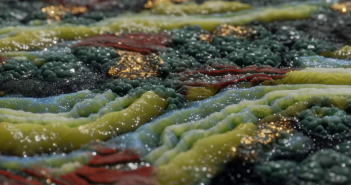As the market for graphics tablets continues to expand, artists are presented with a wide array of tools that aim to enhance their workflows and processes. Blender is a great platform to test and use graphic tablets with its versatility and its inclusion of multiple workflows that benefit from a pen/touch interface, such as the sculpt mode and grease pencil. An extra screen is also always a welcome addition to display one or more of Blender's numerous editors.
This is where this post/review comes in: one of the leading graphics tablet makers, Huion, has provided us with a review sample of their brand-new professional 16-inch tablet, the Huion Kamvas Pro 16 (2.5K). It's important to note that this does not grant them editorial control over the review. The tablet positions itself as a top contender in this space, promising high resolution, color accuracy, and user-friendly features. Given its competitive pricing and robust specifications, this review explores whether it lives up to its potential as an added tool in a Blender User's toolbox.
This review has three major components: First, I will talk about the physical aspect of the tablet itself, its specs, the packaging it came in, and more. Then I will go over Its performance with Blender across multiple modes. Finally, I will talk about its potential as a screen replacement/hybrid and my experience with daily driving it for over two weeks. Let’s jump right in!
What’s in the box
The tablet was delivered quite fast, with it being shipped from a warehouse in Germany to my location in Paris. One of my main concerns at this stage was the packaging, as the weight, size, and fragile nature of such a device are a perfect combo for being damaged during transit. My fears were quickly dissipated when I saw that the tablet was pristinely packaged in a sleek (keep this word in mind, as it will be the main theme of this review) box coming in at a slender 3.4 kg, which is lighter than I expected for a tablet this size
The box also contained everything needed to hit the ground running: a drawing glove, a, a pen holder and pen tip replacements, a foldable stand, and all the connectors needed for all types of connections.
The Tablet: Looks and Specs
Straight out of the box, I am absolutely enamored with the tablet's sleek design and build quality: It feels incredibly sturdy, and surprisingly thin, I almost wanted to use it as a tablet.
 The tablet itself weighs 1.28kg. The tablet features a sleek, aluminum alloy case that not only gives it a premium feel but also aids in heat dissipation, ensuring the device stays cool during extended use. It is remarkably slim and lightweight, making it easily portable for artists on the go. The included adjustable stand offers multiple angle settings, accommodating various drawing and usage positions. Eight customizable buttons flank it on one side, on top of the two buttons on the passive pen.
The tablet itself weighs 1.28kg. The tablet features a sleek, aluminum alloy case that not only gives it a premium feel but also aids in heat dissipation, ensuring the device stays cool during extended use. It is remarkably slim and lightweight, making it easily portable for artists on the go. The included adjustable stand offers multiple angle settings, accommodating various drawing and usage positions. Eight customizable buttons flank it on one side, on top of the two buttons on the passive pen.
 The 15.6-inch display boasts a 2560x1440 QHD resolution that delivers sharp, vibrant visuals critical for fine detail work in 3D texturing and sculpting, at up to a 178° viewing angle. The anti-glare, fully laminated screen reduces distracting reflections and minimizes the parallax error. Although the refresh rate is not the highest on the market, it is sufficient for most digital art tasks, providing a smooth visual experience without significant lag.
The 15.6-inch display boasts a 2560x1440 QHD resolution that delivers sharp, vibrant visuals critical for fine detail work in 3D texturing and sculpting, at up to a 178° viewing angle. The anti-glare, fully laminated screen reduces distracting reflections and minimizes the parallax error. Although the refresh rate is not the highest on the market, it is sufficient for most digital art tasks, providing a smooth visual experience without significant lag.
Installation and Setup
My experience connecting the tablet was seamless: I simply plugged the USB-C to USB-C cable into my usb-c display port, downloaded and installed the appropriate driver from the Huion website, and everything worked like a charm!
 There are many ways to connect the tablet to the computer, here's a video by Huion explaining all the methods:
There are many ways to connect the tablet to the computer, here's a video by Huion explaining all the methods:
The Tablet Software
 The tablet software is minimalistic yet very intuitive to use: Setting up key binding and working areas is a breeze, and I especially enjoyed the pen pressure tester allowing to quickly customize the pen's pressure curve.
The tablet software is minimalistic yet very intuitive to use: Setting up key binding and working areas is a breeze, and I especially enjoyed the pen pressure tester allowing to quickly customize the pen's pressure curve.
Software presets can also be saved with different bindings for each, once again with great ease of use.
 One slight annoyance is the presence of the store tab in the software: An unfortunate misclick will open up your browser and send you straight to the Huion store: A weird addition since you already are using one of their products, and this self-referential ad on their own product is not welcome.
One slight annoyance is the presence of the store tab in the software: An unfortunate misclick will open up your browser and send you straight to the Huion store: A weird addition since you already are using one of their products, and this self-referential ad on their own product is not welcome.
Experience in Blender
I was immediately impressed by the pen's feel and response: The etched glass makes for a better sensation, and the pen is extremely responsive. Equipped with PenTech 3.0 technology, the stylus of the Kamvas Pro offers 8192 levels of pressure sensitivity and ±60° tilt recognition, allowing nuanced control over brush strokes and texture detailing, which is essential in Blender's sculpting and texture painting modes. The high report rate ensures that the cursor tracks the stylus movement accurately.
The pen was immediately recognized in Blender and I faced no compatibility issues, the experience was really as seamless as can be. I programmed one of the pen's button to be middle click, allowing me to easily navigate in the viewport.
Daily Driving it as a Secondary Monitor
A great bonus aspect of this tablet for me is its potential place in a dual-screen setup, as a secondary computer monitor. As you may have gleaned from my pictures, I live in a tiny Parisian apartment, where space is a scarce resource to be carefully managed. As a very heavy Blender user, a writer, and working a few days from home per week, a good secondary screen setup is necessary, but having a graphics tablet and two screens is a no-go because of space. The versatility here is key, where a graphics tablet would have to double as a monitor, and this one performed admirably in most situations, with its high resolution QHD display, great color coverage, a plethora of buttons, a smart menu overlay, all in a compact package.
However, there are three caveats to be aware of when considering this tablet for a secondary monitor setup: First, while the brightness was perfectly adequate at 220 nits in my setup (helped by its antiglare coating), It might be just a tad too low in more sun-lit rooms and desks. Second, it's a shame that the provided tablet stand doesn't allow for vertical or near vertical positioning, something that would be quite useful for a secondary monitor setup. And finally and unsurprisingly, the screen's response time makes it inadequate for gaming.
Final Thoughts
The Huion Kamvas Pro 16 (2.5K) is a compelling option for professionals and hobbyists seeking a high-quality drawing tablet. It combines excellent display and performance features with practical design and software flexibility at a competitive price point. It's sleek, modern, and lightweight design makes it a joy to use and invites experimentation with it. In my case, the experience setting it up and using it with Blender was seamless from a driver/software standpoint, and the hardware performs admirably at the price point in most use-cases, easily doubling as a secondary monitor in a compact setup and perfectly suited for heavy Blender usage, with the caveat of okay brightness and unsuitable screen responsiveness for gaming.

















